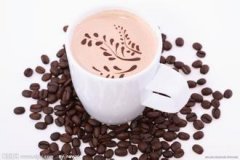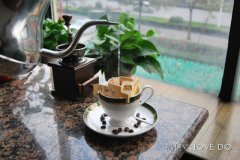Recycling of coffee grounds to make clothes
In December, Victorias Secret's London lingerie show, sexy supermodels, beautifully designed lingerie and gorgeous stage effects made the Victoria's Secret brand once again the hottest topic in the world. Previously, Xingzai, an environmentally friendly textile brand from Taiwan, had received large orders as early as October, becoming a key link in its supply chain.

Founded in 1989, Xingcai Industry is a professional textile company dedicated to R & D and production of functional fabrics. For most people in the industry, what is familiar is their coffee yarn products. In addition to Victoria's Secret, sports brands such as Nike, THE NORTH FACE and Puma are also loyal customers, and orders from these three customers now account for 35 per cent of Xingcai's total revenue in 2013.
If you just look at the soft, breathable touch of the fabric, it's hard to imagine that such a star product is taken from abandoned coffee grounds and plastic bottles.
Chen Guoqin, the 50-year-old chairman of Xingcai Industrial Co., Ltd., comes from a textile family. Xingcai was founded as a small quilt factory, but Chen Guoqin's ingenious idea made this small Taiwanese company the first company in the world to develop coffee grounds textile fabrics. The clothes made of coffee grounds can not only achieve effective perspiration, but also have the effect of sterilization and cleaning. In this way, Xingcai not only won the gold medal awards of the three major international invention exhibitions in the United States, Germany and Switzerland, but also won five patents related to coffee grounds.
Research and development
Coffee is one of the most popular drinks in the world at present. According to statistics, 1 billion people around the world drink coffee every day, and coffee has become the second largest futures trading commodity in the world. People like the mellow aroma of coffee and the refreshing effect of this drink. But few people know that only 0.2% of coffee beans are used during cooking, the rest are 99.8% of coffee grounds, and few people realize that coffee grounds have other uses as well.
In 2005, when Chen Guoqin was having coffee with his family at Starbucks in Taipei, Mrs. Chen Guoqin noticed that the shop assistant used coffee grounds to taste in the kitchen, so she jokingly told Chen Guoqin that if coffee grounds were smeared on people who had finished exercising, it wouldn't smell like sweat. It was this joke that inspired Chen Guoqin's desire to develop coffee gauze. "in Taiwan, 40 tons of coffee grounds are produced in a day, and if these raw materials are used effectively, it will be a very good business."
It comes at a time when textile companies in mainland China and Southeast Asia are on the rise, because labor costs in the two places are cheaper than in Taiwan. Therefore, many textile enterprises have to sacrifice the quality of goods to reduce costs to compete in the market. However, Chen Guoqin, who is unwilling to reduce the quality, plans to transform the factory into chemical fiber materials. This is the way he hopes to gain a foothold in the highly competitive Taiwan market, and he must pursue to be unique.
Therefore, in order to practice the conjecture of making coffee grounds into fabric, Chen was haunted by it, and he began to immerse himself in the research. It took a total of two years from the first generation to the fourth generation. In order to ensure the applicability of the fabric, Chen would make clothes for friends and business partners to try on each generation of products developed. But when the fourth-generation products were tested, Chen Guoqin found a problem that was difficult to solve.
When the experimenter first got the clothes, they emitted a relaxing faint aroma of coffee. But a few months later, Chen Guoqin was told one after another that there was a stench that could not be removed at all. This unexpected question made Chen Guoqin give up at one point. "did I go in the wrong direction in the first place?"
However, he soon discovered that the source of the smell was the aroma of coffee that he had deliberately retained in order to attract consumers. Because the coffee oil in the coffee grounds is not extracted clean, the sweat produced by human exercise combines with the coffee oil to produce a bad smell. As a result, after a further investment of more than NT $10 million, the coffee oil in the coffee grounds was extracted, ground to 400 nanometers and added to the yarn produced by wire drawing from waste plastic bottles, and the eighth generation coffee yarn finally achieved a perfect deodorization function.
From the beginning of research and development in 2005 to the completion of all the tests at the end of 2008, Chen Guoqin spent a total of 2 million US dollars. "the process put a lot of energy into it, and it was very hard, and I was about to give up several times. But I know that unless the deodorizing function of coffee grounds does not exist, there is definitely a way to realize my guess. "
At the end of 2008, after the S.Caf é coffee yarn developed and produced by Xingcai was exhibited in Germany, it immediately attracted the attention of major international manufacturers, among which EiDER, the first outdoor function brand in France, was the first to cooperate with Xingcai and launched a variety of functional sweat clothing in the second year. In 2009, in the first year of Xingcai's launch of coffee yarn, this product brought NT $100 million in revenue to Xingcai.
At present, coffee yarn has become the main driving force for the growth of mining revenue. In 2013, revenue from coffee yarn products reached NT $342.5 million, accounting for 25 per cent of total revenue and a year-on-year increase of 35 per cent. Also because of the innovation of coffee yarn, the overall gross profit margin increased from 20.44% in 2010 to 23.52% in 2012.
With regard to the environmental benefits of using coffee yarn to make clothes, Jiang Bowei, overseas marketing director of Xingcai Brand Department, vividly described that as long as 3 cups of coffee and 12 and a half plastic bottles can be used to make a coffee gauze coat. In fact, not only the raw material of coffee yarn itself comes from recycled resources, but also its production process is energy saving and carbon reduction, and it has been certified by the extremely strict Swiss Blue Mark Standard (Bluesign Standard) in the textile industry. This standard is jointly set by EU academia, industry and relevant organizations and represents the most stringent environmental standards for textiles. Xingcai abandoned chemical solvents such as acetone and used the method of low temperature and high pressure to extract oil with 80% less carbon emissions than the traditional method. In addition, compared with the disadvantage of large amount of carbon dioxide produced by coal heating in traditional cloth dyeing mills, natural gas is used as fuel. Although the cost has increased fourfold, it emits a total of 1300 to 2750 tons of carbon a year.
If you consider the production cost, although coffee yarn does not have an obvious advantage in cost compared with traditional textiles, "although the price of coffee yarn clothing is not much different from that of ordinary clothing, there is a great breakthrough in functionality," Jiang Bowei said. although the production cost of coffee yarn is 20% to 30% higher than that of traditional yarn, in fact, each piece of clothing will have the function of deodorization and heat preservation as long as 35% coffee yarn is added. Therefore, the cost will not increase too much.
Diversification
At present, large clothing brands, especially sports brands, are more concerned about the environmental protection of raw materials, which is the general trend of the clothing industry. Therefore, in addition to constantly improving coffee yarn products, Xingcai has also been developing new coffee grounds products in recent years.
One of the main procurement items in the order signed with Victoria's Secret is the acquisition of self-developed AIRNEST foam. The foam uses coffee grounds to replace 100 per cent of PU foam made from oil and at least 25 per cent of petrochemicals. While effectively reducing the waste of resources, the product also has practical functions such as deodorization and sterilization.
In addition, the waterproof film produced with coffee oil has the characteristics of good elasticity and light weight. Although the thickness is extremely thin, there is an incomparable performance of other materials in waterproofing. Using coffee oil raw materials and introducing hydrophilic agents into the materials at the same time, the waterproof film not only has high waterproof performance, but also has excellent moisture permeability. Only human sweat can penetrate between the films. In 2013, Xingcai developed its own environmentally friendly and comfortable printing of coffee grounds, printing coffee grounds particles on cloth to achieve moisture absorption, quick drying and odor control.
Now, more than 99% of Xingcai's products are sold to overseas markets and have long been the partners of more than 100 well-known outdoor clothing brands. For example, clothing, shoes, bags, etc. of brands such as North Face, New Balance, Timberland, Hugo Boss, Li Ning, Pathfinder, and even the uniforms of Starbucks coffee shops are made of coffee yarn. In addition, in addition to coffee gauze products, coffee oil extracted from coffee grounds is also exploited to produce a variety of daily chemicals.
Chen Guoqin told Global Entrepreneur that Xingcai's cooperation with Nike, Beifang and other brands involves technical exchanges. The focus of cooperation with these brands is not only to do internal tests in the laboratory, but also to wear real people to participate in outdoor sports for at least half a year, and constantly improve the function of the products in the process.
At the same time, as a customer who has been cooperating for 15 years, Nike has many products made of coffee yarn, and they adopt a scoring system when inspecting suppliers. The specific criteria are composed of pollution index, energy consumption index, environment-friendly index and so on. Once one fails to meet the standards, it will not be able to pass Nike's inspection. Therefore, to be able to maintain such a cooperative relationship for so many years, it is enough to see the quality advantage of Xingcai coffee yarn.
In order to further expand the scale of coffee yarn industry, Xingcai established a "coffee yarn industry strategy alliance SPIIN" in Shanghai in 2013.
"the textile technology in the mainland is also getting better and better. We give patents to the manufacturers through the cooperative supply chain system, and we all work together to promote the rise of the coffee yarn industry." Chen Guoqin told Global Entrepreneur that at present, the raw material production of coffee yarn is still in Taiwan, but he hopes to integrate upstream and downstream textile companies and garment designers through this alliance, so as to unite the supply chain resources of the textile industry in the mainland. enter the European and American brand market.
Next, Xingcai hopes to set up a factory in the mainland to create its own clothing brand, from the manufacturing side to a brand.
Important Notice :
前街咖啡 FrontStreet Coffee has moved to new addredd:
FrontStreet Coffee Address: 315,Donghua East Road,GuangZhou
Tel:020 38364473
- Prev

Coffee Investigates the Real Reason Coffee Fascinates Us
About a billion people start their day with a cup of coffee first thing in the morning. Among these 1 billion people, the proportion of Chinese people is increasing year by year. A survey shows that 70% of the Chinese people drink coffee, and 30% of them have formed the habit of drinking coffee every day. However, since childhood edification in the fragrant pleasant tea culture of us, always feel and bitter rich
- Next

Studies have found that coffee contains a large number of antioxidants can inhibit liver cancer.
According to Singapore's Lianhe Zaobao, Lasson of the Karolinska College of Medicine in Sweden and Dr. Volcker jointly published a report in the American Journal of Gastroenterology. The medical community has accumulated a lot of research data on the potential benefits of coffee on liver function and liver disease over the past 20 years: several studies have found that drinking coffee is inversely proportional to liver enzyme levels, while liver enzyme levels are associated with risk.
Related
- What is the standard process for the purpose of coffee cup testing? What is the difference between hand-brewed coffee and cup testing?
- How to use hand-brewed coffee paragon small golden balls? How does cold coffee lock in the aroma of coffee?
- Is American coffee black? What is the difference between American coffee and drip coffee?
- Unexpected! Well-known tea beverage brand Lele Tea will withdraw from the Zhengzhou market!
- Starbucks enters the fashion and beauty industry?! Netizen: Give me an ice American eye cream
- Why can American refills for free? The difference between Americano and American drip pot coffee
- Being chased out of the rain in front of Starbucks?! Store: Sheltering from rain under umbrellas poses a safety hazard
- The white moonlight has changed?! Lucky launches "Big Winter Pear American"
- Hand-brewed coffee three-stage method, high-sweet and universal brewing method to share! What does the high sweet water level of hand-brewed coffee mean?
- What is the difference between raw, refined and full espresso coffee? How to extract espresso and taste good?

